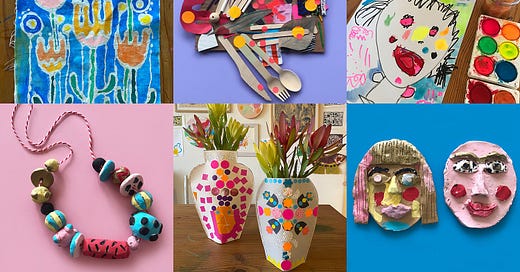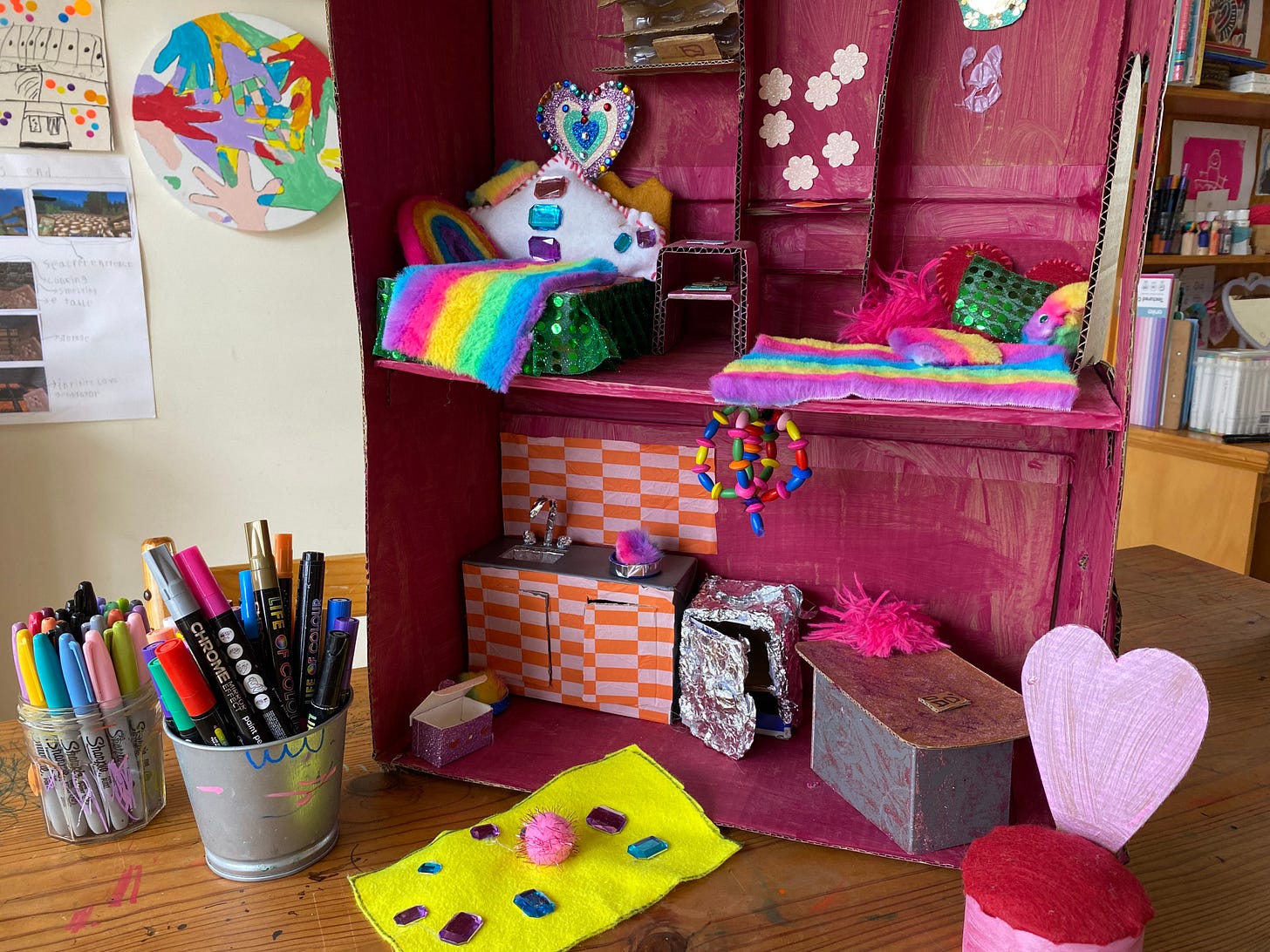CRAFT - What is it good for?
Why do I do art and crafts with my children? And why do I share those creative ideas with others?
I often ask myself why I’m here on Substack, and on Instagram, spending so much of my time sharing art and craft activities with the world?
Firstly, I am a maker. Even if I hadn’t started a business centered around children’s creativity, I would still be making crafts at home with my children and for myself. I make purely for the joy of having made something. It is a huge part of who I am. I can’t help but create.
But, why share those creative pursuits with the rest of the world?
Well, let's start with one thing I’m not trying to do. I’m not here trying to profess that my crafty family life is somehow better than another way of being. I’m not trying to say you need to be doing all these crafts with your kids to be a good parent.
The reason I share my creative pursuits online is that I value myself and my skills. It has taken me a long time to reach this understanding, to recognize that my creative ideas are valuable. I have something to offer, and these ideas can be valuable to others. And so, I created a small, but fulfilling, business, based around sharing my creative knowledge. I feel so privileged to have been able to build my creative passion into a job and I love sharing my joy for making with the world.
I also feel creative activities can be a fantastic way to make connections with others and build community, which is something I’m very passionate about.
Looking deeper, beyond my personal and professional joy in creativity,are there other reasons I do art and craft with my children?
There are many Instagram accounts and blogs out there sharing craft ideas that encourage early literacy and numeracy; elaborate sensory play trays or early writing skills cleverly disguised in crafts. This has never been my jam. Whilst I’m sure these types of educational focused art and craft blogs are all very well meaning, I feel that, at times, they can fuel anxiety for parents. They send the message that if you are not facilitating all manner of creative learning projects to encourage academic skills at a young age, your children will somehow be at a disadvantage. They will ‘fall behind’. As a parent, who cares deeply for my children, I too feel that anxiety. I understand that it is easy to be co-opted into feeling you need to be constantly pushing ‘educational’ activities at a young age. You don’t.
The pressure to facilitate early academic based activities can contribute to the exhaustion and burnout of parents and feelings of shame. If you can’t keep up the pace in supplying stimulating projects or if your children are not interested or engaged with such activities, you are somehow failing as a parent. This is not true.
I will also add, that I feel the idea of being ‘ahead’ or ‘behind’ in relation to childhood development is really toxic. It sows the seed in us, from an early age, that we need to constantly compare ourselves with others. Which in turn fuels continued competitiveness as we grow, which feeds into an individualistic way of thinking and a consumerist capitalist society. If you don’t have a problem with capitalism, you might not see a problem with this, but I do. I appreciate that this is a hugely oversimplified leap, but everything is connected!
There is a growing body of research that concludes that early academic tuition at preschool age, in comparison to lots of free play, has long-term damaging effects on children's social, emotional, intellectual, and academic development. Conversely, you could also conclude that lots of free play during childhood has a benefit to social, emotional, intellectual and academic development in later life. If you want to go further into research on this area, Peter Grey writes extensively on this topic in recent articles and his book Free to Learn.
Before I end my rant on the pushing of early academics in the guise of crafts on social media, I want to add, I hope the content I have shared online through my business MINI MAD THINGS hasn’t contributed to parental anxiety and the feeling that we need to do all the things in order for our children to ‘succeed’. This has never been my intention.
Whilst I recognise that many crafting activities, like playing with play-dough or threading, have great benefits for developing fine motor skills which in turn can help with developing the muscles needed for literacy skills, this isn’t my primary reason for crafting with my children.
For me, I have always taken a slightly more expansive view of the benefits of pursuing art and craft activities. The three key benefits I have noticed, with my children, over our years of crafting together are creative thinking, resourcefulness and confidence.
CREATIVE THINKING
Being able to think creatively goes hand-in-hand with problem solving. Artistic projects, embarked on by both children and adults alike, allow the practice of creative thinking and problem solving skills in a low risk environment.
‘There are so many big problems in the world, sometimes what I most appreciate about art making is the “low stakes” opportunity to practice navigating challenges. Art is one of the best ways I know to practice problem solving, to practice disappointment, to get curious and to practice life.’ Jen Bloomer - Creatively Rooted.
As stated by educator and speaker Ken Robinson in his 2006 TED talk, Do schools kill creativity?;
‘If you are not prepared to be wrong, you will never come up with anything original.’
When making art and craft, you can practice ‘being wrong’ without major consequences, solve those problems and try again, allowing the development of creative thinking and problem solving abilities. These skills can then be applied too all areas of life, not just art and craft pursuits.
RESOURCEFULNESS
Resourcefulness, which is strongly linked to creative thinking and problem solving, is defined as the ability and ingenuity to cope with difficult situations, or unusual problems. It is about getting things done in the face of obstacles and constraints.
This is a skill that I have seen develop in my daughter, particularly in the last few months. She will have an idea about a game or toy she wants to play with and her first thought is ‘can I make it?’ She then looks around the house for materials. Inevitably she won’t be able to find everything she needs, so we might have a discussion about materials she could substitute to make her ideas work. She is being resourceful with the materials we have available and bringing her idea to fruition in the face of obstacles and constraints.
From an early age we always crafted using a variety of materials and techniques. We have drawn, painted and sewn together. Made doll’s clothes, cardboard cubby houses and wooden toys. We have experimented with clay and printmaking. She has seen me crochet blankets, sew quilts, fix old clothes, do DIY around the house and much more. Gradually, without too much explicit instruction, the idea of being resourceful has seeped into her way of thinking.
CONFIDENCE
This leads me to confidence. Through the process of crafting together, and observing me making all manner of creations, my daughter has had time to try and experiment with many creative skills using her hands. This had led to her ever growing confidence in her own creative abilities. So now, even when faced with an unfamiliar craft or new idea, she has the confidence to just have a go. She will try, possibly fail, try again and learn through the process. This self-confidence is then applied to other areas of her life.
I have found, embarking on creative pursuits with my children over the years has been a joyful and fulfilling way to practice these three interconnected skills of creative thinking, resourcefulness and confidence. These undoubtedly important skills allow a person to be adaptive and cope with varied situations, which in our quickly changing and turbulent world, I feel will be beneficial for their unknown future.
I love sharing my passion for making with my children, however, I want to add that even though creativity is important to me, it’s an integral part of who I am, I always try to remind myself that my children are not me. They are their own people with their own interests, skills and passions. I may choose to share my creative passion with my family, but they are free to take from it what they will, without judgment or pressure.
So, returning to my original questions; Why do I do art and crafts with my children? And why do I share those creative ideas with others?
Personally, I make art because I love it, it is part of who I am.
I do art with my children because it creates joyful connection and the opportunity to practice important life skills.
I share my creative ideas with others because I value myself and my skills. Also, I get stupidly excited about all creative things and can’t help myself from sharing my love for art.
I hope you enjoy the creative inspiration I’m putting out into the world!
Thank you for being here and reading Creative Spaces. If you have enjoyed my work, please share with a friend.
REFERENCES:
Articles by Peter Grey from his Substack Play Makes Us Human.
TED talks by Ken Robinson on the importance of creativity in education.
One of my favourite Substacks, Creatively Rooted by artist and activist Jen Bloomer.







